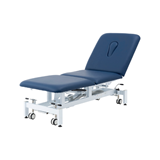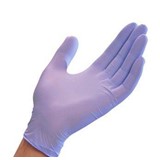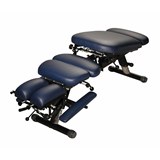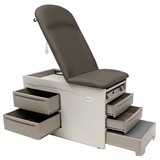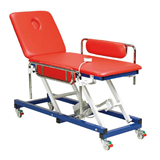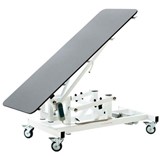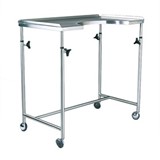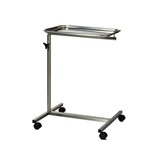I. introduction
When it comes to outfitting your medical practice, choosing the right examination table is crucial. A well-informed decision ensures both patient comfort and efficient medical examinations. In this buying guide, we will provide you with valuable insights and expert recommendations on what to consider before making your purchase. Maintaining an informative, professional, objective, formal, technical, clear, concise, neutral, and authoritative tone throughout, let's dive into the key factors to keep in mind.
II. Understanding the Different Types of Examination Tables
A. Fixed Examination Tables
- Description: Fixed examination tables have a stationary design with a fixed height and position.
- Benefits: Sturdy and low maintenance, suitable for specific medical procedures.
- Considerations: Limited adjustability may not accommodate diverse patient needs.
B. Adjustable Examination Tables
- Description: Adjustable examination tables offer height and sometimes angle adjustments.
- Benefits: Versatility in accommodating various patient positions and procedures.
- Considerations: Mechanical components may require maintenance over time.
C. Hydraulic Examination Tables
- Description: Hydraulic examination tables use hydraulic systems for height adjustments.
- Benefits: Smooth and quiet height adjustments without the need for power outlets.
- Considerations: Hydraulic systems may require occasional servicing.
D. Specialty Examination Tables
- Description: Specialty examination tables cater to specific medical specialties.
- Benefits: Tailored features to meet specialized medical examination requirements.
- Considerations: Limited usability outside the intended medical specialty.
III. Assessing the Needs of Your Medical Practice and Patients
When it comes to selecting the right examination table for your medical practice, a thorough assessment of your specific requirements is essential. By considering various factors related to your medical specialties and patient demographics, as well as evaluating the frequency of use and multi-functionality needs, you can make a well-informed decision. Additionally, taking into account the ergonomics and workflow efficiency of the examination table will contribute to a seamless and comfortable patient experience.
A. Identifying Specific Requirements
Begin by identifying the unique needs of your medical practice. Consider the types of medical examinations regularly conducted and the various procedures that the examination table will be used for. Take note of any specific features or functionalities that are crucial for your practice's daily operations.
B. Considering Medical Specialties and Patient Demographics
Different medical specialties may require specific examination table features to ensure optimal patient care. For example, gynecological examinations may necessitate stirrups, while orthopedic practices might benefit from a table with adjustable height and positioning capabilities. Additionally, consider the age and mobility of your patients, as this will impact the table's accessibility and safety features.
C. Evaluating Frequency of Use and Multi-functionality Needs
Assess how frequently the examination table will be used throughout the day. High-traffic practices may benefit from durable and easy-to-clean materials. Moreover, considering multi-functionality can be advantageous, as it allows the table to serve multiple purposes, potentially reducing the need for additional furniture.
D. Ergonomics and Workflow Efficiency
Ergonomics plays a critical role in both patient and healthcare provider comfort. An ergonomically designed examination table can minimize strain and fatigue during examinations, enhancing overall efficiency. Pay attention to features like adjustable height, easy patient transfer, and conveniently located controls.
IV. Key Features to Look for in Examination Tables
When purchasing examination tables, it is crucial to consider several key features that contribute to its overall functionality, patient comfort, and durability. As a healthcare professional seeking the best option for your medical practice, the following features should be carefully evaluated:
A. Comfort and Padding:
Patient comfort is of paramount importance in any medical setting. Look for examination tables that offer adequate padding, preferably made from high-quality foam materials. The padding should be thick enough to provide ample support and cushioning for patients during examinations. Additionally, consider upholstery materials that are easy to clean and maintain while ensuring patient comfort remains uncompromised.
B. Durability and Longevity:
An examination table is a long-term investment, so it is essential to choose a model built to withstand the rigors of daily use. Opt for tables constructed from robust and high-quality materials, such as stainless steel or heavy-duty aluminum frames. Thoroughly assess the build quality and welds for sturdiness. A durable examination table will have a longer lifespan, reducing the need for frequent replacements and repair costs.
C. Safety Features and Infection Control:
Ensuring the safety of both patients and medical staff is a top priority. Look for examination tables equipped with safety features, such as safety rails and locking mechanisms, to prevent accidental falls or injuries during patient transfers. Additionally, consider models with built-in infection control measures, such as antimicrobial upholstery, which helps minimize the risk of cross-contamination and the spread of infections.
D. Height Adjustment Mechanism:
An adjustable height mechanism is an indispensable feature that enhances the versatility and ergonomics of an examination table. It allows healthcare providers to customize the table's height according to individual patient needs and the specific medical procedure being performed. Look for tables with smooth and easy-to-operate height adjustment controls to ensure seamless patient positioning and comfort.
V. Examining Weight Capacity and Accessibility for Diverse Patient Populations
A. Weight Capacity Considerations:
- Importance of Weight Capacity: The weight capacity of an examination table is a critical factor to consider, ensuring the safety and comfort of patients during examinations.
- Determining Patient Average Weight: Assess the typical weight range of your patients to select an examination table with an appropriate weight capacity that accommodates the majority of your patient population.
- Accounting for Equipment Weight: Factor in the weight of medical equipment that will be used during examinations to ensure the combined load remains within the table's capacity.
B. Accommodating Patients with Limited Mobility:
- Importance of Accessibility: An examination table should cater to patients with limited mobility, making the examination process easier and more dignified.
- Low-Height Accessibility: Consider tables with a low height or easy height-adjustment options for patients with mobility challenges, such as the elderly or disabled.
- Transfer Assist Features: Look for tables equipped with transfer assist mechanisms like grab bars or side handles to aid patients in getting on and off the table safely.
C. Ensuring ADA Compliance:
- Understanding ADA Guidelines: Familiarize yourself with the Americans with Disabilities Act (ADA) guidelines related to medical furniture, ensuring compliance with accessibility standards.
- Exam Table Height: ADA guidelines recommend specific height ranges for examination tables to accommodate wheelchair users and those with disabilities.
- Examination Table Clearance: Ensure the table offers adequate clearance for wheelchairs to maneuver close to the table for easy patient transfers.
In conclusion, selecting the right examination table for your medical practice is a crucial decision that impacts both patient comfort and efficient medical examinations. By considering various types of examination tables, assessing your practice's needs, evaluating key features, and ensuring accessibility for diverse patient populations, you can make an informed and practical choice.
Understanding the different types of examination tables, such as fixed, adjustable, hydraulic, and specialty options, provides you with a foundation for your decision-making process. Depending on your medical specialties, patient demographics, and the specific procedures you conduct, you can determine which type aligns best with your practice's requirements.




